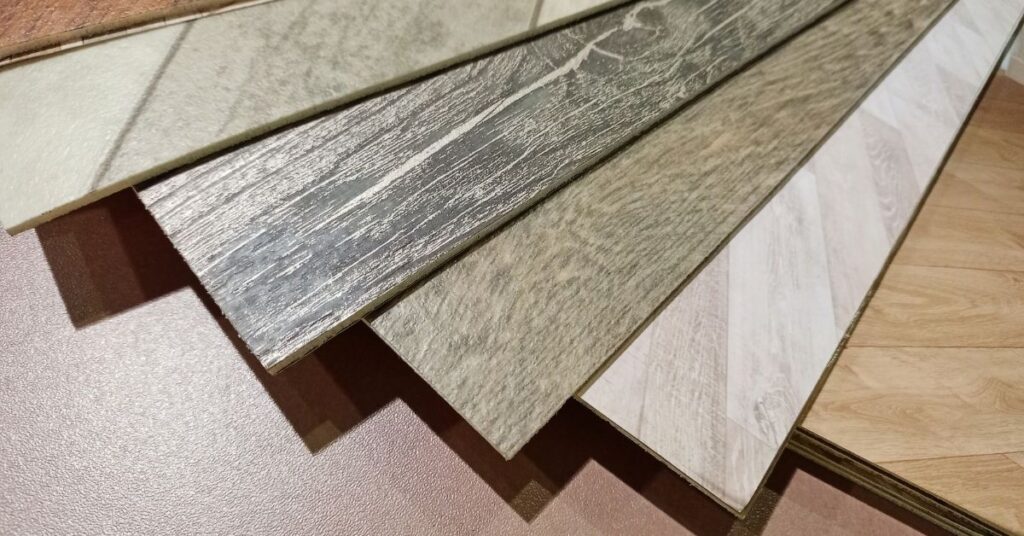Kitchen flooring sets the scene for your entire design scheme. As one of the highest-traffic areas of any home, it must be durable enough to withstand foot traffic, spills, and heat without breaking down quickly. Your choice should reflect aesthetic preferences, lifestyle needs, and maintenance expectations for optimal performance.
Finding the ideal flooring material depends on your lifestyle, budget, and comfort preferences. If you have children or pets that tend to play rough on floors, hardwearing materials like tile or hardwood may be more suitable; alternatively, cork and vinyl offer soft underfoot comfort, while laminate and LVP require less upkeep than these other choices.
Some of the most popular kitchen flooring types include:
Whether you are an accomplished chef or simply enjoy making meals in your kitchen, having a durable floor that can withstand foot traffic and temperature variations will ensure an enjoyable dining experience at home. Wood brings a timeless, natural aesthetic that pairs beautifully with any kitchen design aesthetic and decor scheme. Laminate and LVP materials offer durable alternatives with superior moisture resistance that provide similar visual aesthetics at more reasonable costs. Natural stone offers a stunning visual texture and is known to withstand foot traffic and spills with proper maintenance. Granite tiles for flooring applications or slabs for countertops may last decades if appropriate sealants are applied and maintenance is in place.
Factors to Consider When Choosing Kitchen Flooring
Selecting the ideal flooring for your kitchen requires more than simply picking something that looks appealing; the floor must also be durable enough to withstand heavy foot traffic, spills, splashes, dropped utensils, and daily wear and tear,, and be comfortable underfoot and easy to maintain. There are various factors you should consider when making this decision, such as durability, water resistance, stain, and scratch resistance, as well as cost, installation complexity, and style considerations.
Durability & Foot Traffic
Your kitchen floors must be durable enough to withstand frequent foot traffic from family members darting in and out, appliances being dropped onto them, and any accidental food spillages. Tile and luxury vinyl flooring options excel in this category by offering exceptional resistance against impact damage, scratches, and scuffing; concrete is also very hardwearing, while stone provides natural robustness that complements many design styles.
Water & Stain Resistance
Moisture can be an issue in the kitchen, as spills, splashes, and steam are a daily part of life. Therefore, your, chosen kitchen flooring must withstand moisture damage from spills or splashes; porcelain or ceramic tiles tend to be remarkably resilient to such issues.
Cleanliness & Maintenance
Your kitchen can be a hectic environment, making having easy to keep clean flooring a priority for making life simpler. Cork and bamboo offer eco-friendly flooring that won’t break the bank while providing soft cushioning underfoot for maximum comfort.
Cost and Installation Complexity
While durability is, ,an important consideration when choosing kitchen flooring, the cost and complexity of installation must also be considered when making this selection. Installation costs vary based on the material selected, installation method employed, and environmental conditions (i.e., high humidity levels may inhibit curing processes requiring longer wait times until new floors can be put to use).
Style and Aesthetics
Achieving a beautiful kitchen floor design is equally as essential to its functionality and durability. With so many flooring styles to choose from, there’s sure to be one that matches your design preferences – from wood’s warmth to concrete’s sleek appearance, there is something suitable for everyone here.
Also Read: – Kitchen Cabinet Replacement vs. Refacing
Types of Kitchen Flooring & Their Pros and Cons
Pros: Tile flooring is an enduring classic that works well in almost every design style. Its durability stands the test of time while being easy to maintain and clean up after.
Natural stone adds an elegant aesthetic to kitchens and, with proper care, can last a lifetime. Refinishing can help preserve its appearance over time.
1. Tile Flooring (Ceramic & Porcelain)
Ceramic tile flooring is a highly desired material in kitchens and bathrooms, foyers and mudrooms,, living spaces and bedrooms in warmer climate homes.
Ceramic and porcelain tiles are highly resilient and water-resistant and come in various colors, sizes, and designs. Ceramic is generally more water resistant than porcelain, while both tiles require little upkeep, with mopping or sweeping being an easy solution for clean-up purposes. Ceramics are especially great as a wall covering due to their water repelling qualities, while porcelain may last decades with proper care and cleaning routine.
Materials made of PVC don’t react with chemicals and humidity and can withstand high levels. Unfortunately, they can feel cold underfoot without radiant heating installed – some surfaces even become slippery with time! Repairs to cracks or chips in PVC tiles may require professional installation to be effective – the former should be prioritized over the latter option.
2. Hardwood Flooring
Hardwood flooring is an elegant classic that instantly elevates any kitchen while remaining durable and versatile enough for use in many different species, finishes, and styles.
Wood and moisture don’t go together well, and spills should be cleaned up as soon as they occur toto avoid warping hardwood surfaces. Luckily, modern water-resistant sealers and polyurethane coatings keep hardwoods looking their best!
COREtec wood floors, for instance, feature real wood veneer on a high-density fiberboard or plastic core for moisture resistance and repeated sanding/refinishing; however, their top layer remains susceptible to staining and scratching. A better choice for areas prone to moisture may be luxury vinyl plank (LVP), which can look like hardwood but resist stains and scratches more effectively.
3. Vinyl Flooring
Vinyl flooring is both cost-effective and comfortable underfoot. Easy to maintain and water-repellant, vinyl can make an excellent addition to any kitchen space.
Standard vinyl floors can be designed to look like ceramic or stone tiles, while printed versions may also attempt to pass for wood grain flooring. Although this material may pass for natural flooring in appearance, standard vinyl can usually be identified as being synthetic.
Luxury Vinyl Tile (LVT) and vinyl roll products offer more sophisticated solutions designed to look more authentic. LVT comes in plank or tile form and uses the click-float method, making installation more straightforward for DIYers and providing more excellent dimensional stability than standard vinyl products.
4. Laminate Flooring
Laminate flooring has long been a top choice among homeowners for its affordability and durability. Thanks to modern technology, laminate can now mimic the look of wood or stone floors at a fraction of their costs; its ,sitsghtforward installation and upkeep are added benefits.
Laminate floors differ from engineered wood flooring by being constructed on a plywood sub-base and finished with real 100-percent wood veneer, while their authentic look comes from printed image layers. Dark laminate adds richness and elegance, while lighter shades help bring more natural light into small rooms or areas with limited natural lighting. Laminate is moisture-sensitive, so it should only be installed in bathrooms or laundry areas.
5. Stone Flooring
Natural stone flooring adds elegance and luxury to any room while extremely durable for high-traffic areas. When properly cared for, this material will last decades before needing repair.
Granite is well-renowned for its durability and variety of color choices. Honing allows a flat surface that shows less dirt, while polishing can add sheen, and it can even be brushed for an aged appearance that evokes natural wear over time.
Marble is a popular choice for kitchen countertops, creating an upscale, luxurious feel in any space. Its versatility extends from offering multiple color choices and stain resistance features to being etched for increased stain protection.
6. Concrete Flooring
Concrete floors offer an aesthetically pleasing and eco-friendly option that’s also moisture resistant. Area rugs can help make these hard floors more comfortable.
Hardwood floors have long been considered timeless classics in kitchens. While conventional wisdom once suggested against them due to potential water damage concerns, modern sealers, and polyurethane finishes keep hardwood looking great even through spills and humidity issues.
Bamboo flooring has become an increasingly popular option in kitchens worldwide. Choose between strand woven, engineered, or solid bamboo options – each of which is heat and moisture-resistant.
7. Cork Flooring
Cork flooring is made from ground and compressed bark from cork oak trees, making it a renewable and eco-friendly material. Its softness, comfort, and and insulative qualities make it a fantastic choice for kitchens, children’s bedrooms, and playrooms.
Foam insulation is also an ideal choice for second-floor rooms in multilevel homes, as its millions of tiny air pockets are an effective barrier against sound transmission. Its natural insulating properties also keep rooms warmer during winter and cooler during summer.
Cork floors are water-resistant, but for optimal performance, they require a moisture-proof subfloor to withstand changes in humidity levels and avoid damage caused by humidity fluctuations. They should also be regularly sealed up to preserve their water-resistance qualities and durability.
8. Linoleum Flooring
Linoleum flooring is an economical, durable, hypoallergenic choice that retains heat well, making it easy to lay directly over existing surfaces and maintain over time with strong stain resistance.
Ceramic tile is made of baked natural clay and comes in many colors, sizes, and shapes. Ceramic is an excellent option for kitchens as it can withstand moisture and heat damage without much upkeep required compared to vinyl flooring; cleaning ceramic floors is relatively straightforward, while it should only need sealing every three to four years for best results. Ceramics also mimics natural materials like stone and wood grain patterns for an authentic appearance in their kitchens.
Also Read: – Best Kitchen Worktops: Materials & Costs
Best Flooring for Different Kitchen Needs
If your household includes children or pets, selecting a flooring material that’s easy to maintain and can withstand spills is key. Consider vinyl, linoleum, or cork floors.
Tile offers superior water resistance, and with regular mopping, it will remain looking its best. For a classic look, consider stone flooring like travertine; however, it must be adequately sealed prior to being laid. Engineered wood can also help manage temperature and moisture fluctuations more effectively than solid hardwood options.
High-Traffic Kitchens
Kitchens that tend to make messes, whether due to children, pets, or any other means, require flooring materials capable of withstanding heavy foot traffic while remaining resistant to spills, stains, and impact damage. Choosing flooring materials for these situations can be especially crucial. The right material must withstand heavy foot traffic while remaining resistant to spills, stains, and impact damage – these characteristics must all come together in one piece!
Tile provides superior durability in kitchens with heavy traffic. Ceramic or porcelain tiles can be fired at high temperatures to harden them against scrapes, scratches, and heat while remaining moisture resistant and easy to wipe down and clean.
Hardwood floors add value and style to your home yet are vulnerable to impact damage, stains, and humidity. To maximize protection and avoid these issues with hardwood flooring, choose species with higher Janka ratings and use protective sealants. As an eco-friendly alternative to hardwood, bamboo is another eco-friendly choice: its fast growth allows less deforestation, while manufacturing into planks reduces wood harvest. Bamboo can, therefore, make an affordable yet long-lasting option for high-traffic kitchen areas.
Budget-Friendly Renovations
Laminate flooring offers an economical yet stylish solution for kitchens seeking a classic aesthetic, mimicking reclaimed or scraped wood and stone looks, while water-resistant versions are available for high moisture areas.
Linoleum flooring has made a comeback in trendy cafes and restaurants and can also work effectively at home provided you choose one with a thick wear layer (4-40 mils). Like vinyl, linoleum remains one of the most cost-effective materials in busy kitchens.
Hardwood floors are an elegant classic in any kitchen and add considerable resale value. However, hardwood can be more challenging to refinish than other materials and isn’t suitable for moisture-prone environments such as bathrooms and basements. As alternatives, consider engineered hardwood planks with hardboard veneer or bamboo, which comes in both strand woven and solid varieties. Both are eco-friendly as they don’t involve cutting down tree trunks, and they use recycled materials instead.
Luxury Kitchens
Kitchen floors must be durable to withstand high-traffic areas such as kitchens. The best materials should be easy to maintain and resistant to spills; durability becomes especially essential if there are elderly living in your home or family members with back or knee issues living nearby. Furthermore, flooring must provide comfort underfoot; stone or hardwood are excellent choices that combine durability with soft underfoot surface options while increasing resale value.
Tile flooring offers another cost-effective option with various shapes, sizes, and designs. Ceramic and porcelain tiles are hardwearing materials made of ceramic material; water resistance ensures durability while mimicking natural stone or wood looks. Vinyl sheet flooring can also be found at an economical price point and comes with various patterns, colors, and designs. These designs tend to be quieter underfoot than solid or engineered wood and stand up well against humidity changes and temperature swings.
Easy Maintenance
Vinyl and laminate floors receive high marks for withstanding foot traffic, spills, humidity, stains, and sunlight. Furthermore, their soft underfoot feel may make them desirable in busy kitchens. In addition, vinyl plank and tile flooring come in various designs and colors that resemble other materials, including wood, stone, and concrete.
Ceramic tile flooring is exceptionally long-lasting when correctly maintained, protecting from heat, moisture, and staining. When maintained regularly, it should continue looking its best for decades!
Natural stone flooring and countertop surfaces make a stunning addition to kitchens. Marble is renowned for its elegant veining, lasting decades with proper care. Granite, limestone, slate, and travertine also boast strong visual appeal while being highly moisture resistant – with well-sealed granite floors lasting 100+ years on average!
Also Read: – Open-Plan Kitchen Renovation Tips
How to Choose the Right Flooring for Your Kitchen
Whether you are remodeling an existing kitchen or starting from scratch, selecting the right flooring material is crucial in setting the tone of the space and complementing its design theme. Your chosen material should be durable, easy to clean, and within your budget constraints.
Before making a purchase, carefully evaluate your current kitchen flooring and create a list of desired changes. This helps narrow down options and prevents overspending. Setting a realistic budget and researching material costs, installation methods, and labor rates in advance will ensure that your new floors meet both your financial and lifestyle needs.
Consider foot traffic and usage when choosing flooring. If your kitchen experiences heavy use—frequent cooking, entertaining, or high foot traffic—you’ll need a durable option. Hardwood floors can be prone to water stains, scuff marks, and wear over time, while engineered wood is often a better choice due to its resistance to temperature and humidity fluctuations.
Engineered bamboo flooring is a more durable alternative, designed to withstand temperature, humidity, and moisture changes better than solid wood. Unlike solid wood, which may warp or swell over time due to natural expansion and contraction, engineered bamboo offers excellent dimensional stability, making it a practical choice for kitchens.
Since kitchens are prone to spills, choosing an affordable, stain-resistant flooring material is essential. Options like linoleum, vinyl tile, laminate, and stone tiles each have unique advantages and disadvantages, so comparing all possibilities ensures you select the best fit for your home.
Finally, when choosing flooring, consider the overall aesthetic and style of your kitchen. Think about how much warmth or modernity you want in the space and how the flooring complements existing cabinetry, countertops, and decor to create a seamless design.

Sunny Saini is a certified heating engineer with over 15 years of experience in maintaining and repairing boilers. He specializes in diagnosing complex boiler issues and providing reliable solutions to ensure homeowners stay warm and comfortable throughout the year.





![]=](https://localboiler.co.uk/wp-content/uploads/2024/05/Untitled-design-96-300x300.jpg)